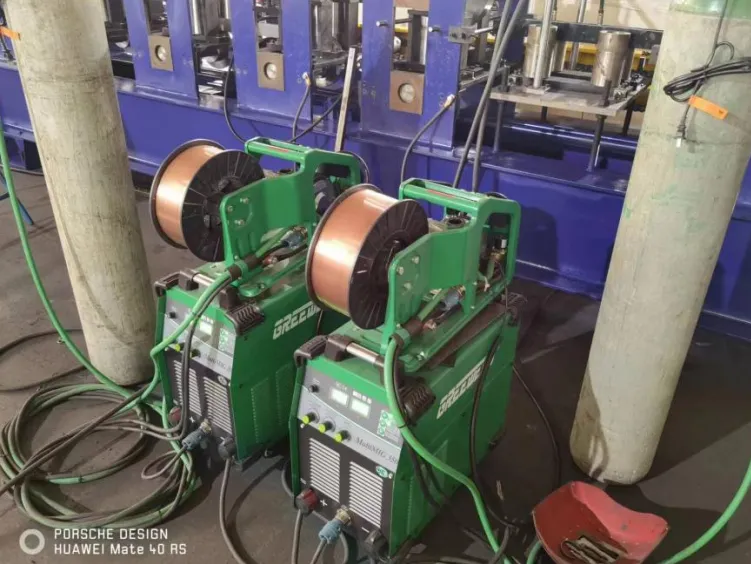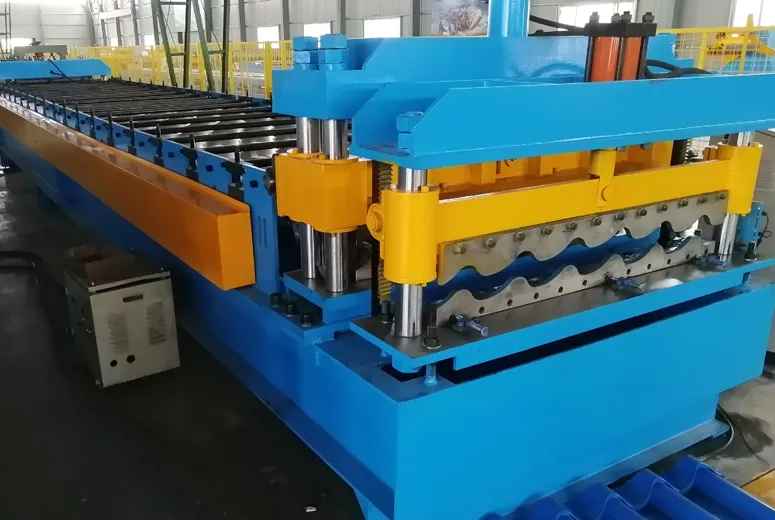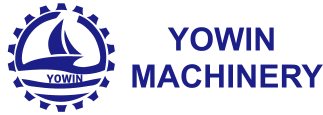High-Performance Shutter Door Roll Forming Machine for Durable Rolling Shutters
- Introduction and market overview of shutter door roll forming machine
s - The core technologies behind roll forming processes for enhanced performance
- Comparative analysis of top manufacturers and their product offerings
- Comprehensive review of material options for roller shutter door roll forming machines
- Understanding and optimizing pricing structures for different roller shutter door roll forming machines
- Customized solutions and real-world application case studies
- Conclusion highlighting the key selection criteria for shutter door roll forming machines

(shutter door roll forming machine)
Shutter Door Roll Forming Machine: Market Insights and Industrial Necessity
Industrial and commercial needs for secure, durable, and efficient entry solutions have driven the surging demand for shutter door roll forming machines. The global market for shutter door roll forming machines, including the widely popular Rolling Shutter Door Roll Forming Machine, is projected to surpass USD 2.8 billion by 2027, registering a CAGR of more than 5.9% during 2021-2027. From warehouse security to retail storefronts, automated and manual systems alike require precision-formed components to ensure long-lasting, reliable operation. These machines automate the process of converting flat sheet metals into high-quality shutter profiles, streamlining manufacturing and reducing manual labor costs by up to 60%. As industries match pace with the evolving demand for fast production, energy-efficient solutions, and tighter tolerances, manufacturers are increasingly investing in advanced roller shutter door roll forming machine lines for scalable, consistent output.
Technological Innovations in Roll Forming for Shutter Doors
The foundation of a high-performance roller shutter door roll forming machine is its advanced engineering and material handling capabilities. Modern systems utilize servo-driven technology, digital controls, and automated punching mechanisms to maximize efficiency. Machines nowadays can achieve line speeds exceeding 25 meters per minute, with precision controls keeping product tolerances within ±0.20 mm. Technological improvements like rapid change tooling, integrated PLC controls, and modular frame constructions have enabled manufacturers to reduce downtime for part changeovers by up to 30%. For example, PLC-based monitoring systems automatically detect and compensate for deformation during forming, resulting in straighter, more uniform shutter profiles. Additionally, upgraded hydraulic shearing units and strengthen shaping rollers accommodate thicker materials, up to 1.2 mm gauge galvanized steel, supporting broader applications in high-security environments. This progression underscores why investing in a technologically advanced roll forming line is a strategic move for businesses aiming for quality and operational efficiency.
Manufacturer Comparison: Market Leaders in Shutter Door Production Lines
With numerous manufacturers offering shutter door roll forming solutions, making an informed purchasing decision requires side-by-side evaluation of equipment quality, technological capability, and after-sales support. Below is a comparative table summarizing leading brands in the roller shutter door roll forming machine sector:
| Manufacturer | Production Speed (m/min) | Max Material Thickness (mm) | Warranty (Years) | Automation Level | Global Presence |
|---|---|---|---|---|---|
| Metform | 20–25 | 1.2 | 2 | Full PLC, Servo | 80+ Countries |
| Brother Union | 18–23 | 1.0 | 3 | Auto Punching & Cutting | 60+ Countries |
| Hangzhou Roll Forming Technology | 20 | 1.1 | 2 | Servo Motor, HMI Display | 50+ Countries |
| BMS | 16–22 | 1.0 | 1 | Manual & Auto Options | 40+ Countries |
| Zhongtuo Machinery | 19–24 | 1.2 | 2 | PLC Automation | 30+ Countries |
This manufacturer comparison highlights not only product speed and thickness capacity but also service reach and automation standards, enabling procurement teams to match offerings with production objectives and regional support needs.
Materials for Roller Shutter Door Roll Forming Machines: Strength and Sustainability
The selection of roller shutter door roll forming machine material directly affects the performance, lifespan, and appearance of the finished doors. The industry primarily utilizes galvanized steel, pre-painted steel, and aluminum alloy, each presenting a balance of structural integrity, corrosion resistance, and cost efficiency. Galvanized steel—typically ranging from 0.8 mm to 1.2 mm in thickness—is favored for heavy-duty commercial and industrial applications, delivering tensile strengths up to 300 MPa. Aluminum alloy, prized for its lightweight properties and rust resistance, is increasingly chosen for retail and residential shutters, supporting easy manual operation and aesthetic versatility.
Pre-painted steel offers customizability and a variety of finishes for branding or architectural harmony, with coatings that enhance resistance to abrasion and weathering. Environmental concerns are propelling the adoption rates of recyclable metals—with over 85% of materials used in European- and North American-manufactured shutter door roll forming machines now coming from recycled sources. Material choice must consider not only mechanical performance but also ease of formability, availability in local markets, and compliance with building codes and green certifications.
Decoding Roller Shutter Door Roll Forming Machine Price Structures
Understanding the factors that influence roller shutter door roll forming machine price can facilitate smarter capital allocation for manufacturers and contractors. On average, a standard production line can range from USD 18,000 to USD 65,000, depending on specifications and automation complexity. Core variables affecting pricing include:
- Material capacity and thickness range: Higher-gauge processing drives up cost due to specialized rollers and stronger frame construction.
- Automation features: Advanced servo controls, auto-punching, and quick-change modules typically add 20-30% to base price.
- Production speed: Lines exceeding 22 m/min command premium due to higher-grade motors and synchronization tooling.
- Brand reputation: Established brands with global service networks and comprehensive warranties typically cost more but minimize downtime risks.
- After-sales support and training: Packages including remote diagnostics, operator training, and extended warranty coverage increase overall investment but enhance long-term value.
According to published cost benchmarks, buyers opting for advanced lines with full automation and galvanizing capacity can expect a ROI period of less than 24 months, particularly for operations with monthly shutter demand of over 8,000 m². Negotiating pricing should take a total lifecycle approach, balancing acquisition cost with predicted maintenance and productivity gains.
Custom Solutions and Application Success Stories
As businesses embrace modernization, manufacturers now offer extensive customization for shutter door roll forming machines—including profile dimensions, embossing patterns, integrated access control elements, and branded color schemes. One notable case featured a logistics center in Germany, where a tailored roll forming system handled both insulated and non-insulated doors on the same line. With the adoption of rapid-change cassettes and a unified control interface, the client reported a 40% reduction in part changeover time and a 22% increase in annual throughput.
In another real-world application, a retail chain in Brazil specified a lightweight, powder-coated aluminum profile requiring custom side guides. The solution, executed by a major Asian supplier, enabled easy manual lifting for staff and contributed to the retail outlet’s modern architectural appeal.
For industrial parks in the Middle East battling sand abrasion and high temperatures, custom-formulated galvanized coatings and reinforced end-lockers were developed. These adaptations extended product lifecycles by more than 35%, reduced maintenance costs, and contributed to better site security compliance. Such projects illustrate the value of partnership with a responsive manufacturer offering robust engineering consultation and localized technical support, empowering clients to achieve operational excellence.
Evaluating & Selecting the Optimal Shutter Door Roll Forming Machine
Selecting the right shutter door roll forming machine requires holistic consideration of application requirements, volume targets, material flow, and integration within existing production lines. Prudent buyers assess machines not only by their technical specifications but also by support frameworks, warranty terms, and scalability options. Manufacturers with proven records in market-specific innovation, sustainable material sourcing, and technological advancement are best positioned to deliver both immediate performance and long-term value.
Ultimately, the ideal investment aligns line speed and quality control features with your project scope, regulatory standards, and return-on-investment objectives. Whether upgrading to an automated system or sourcing your first Rolling Shutter Door Roll Forming Machine, careful analysis of manufacturer capabilities, roller shutter door roll forming machine price, and available roller shutter door roll forming machine material will ensure your production meets world-class standards and withstands the test of time.

(shutter door roll forming machine)
